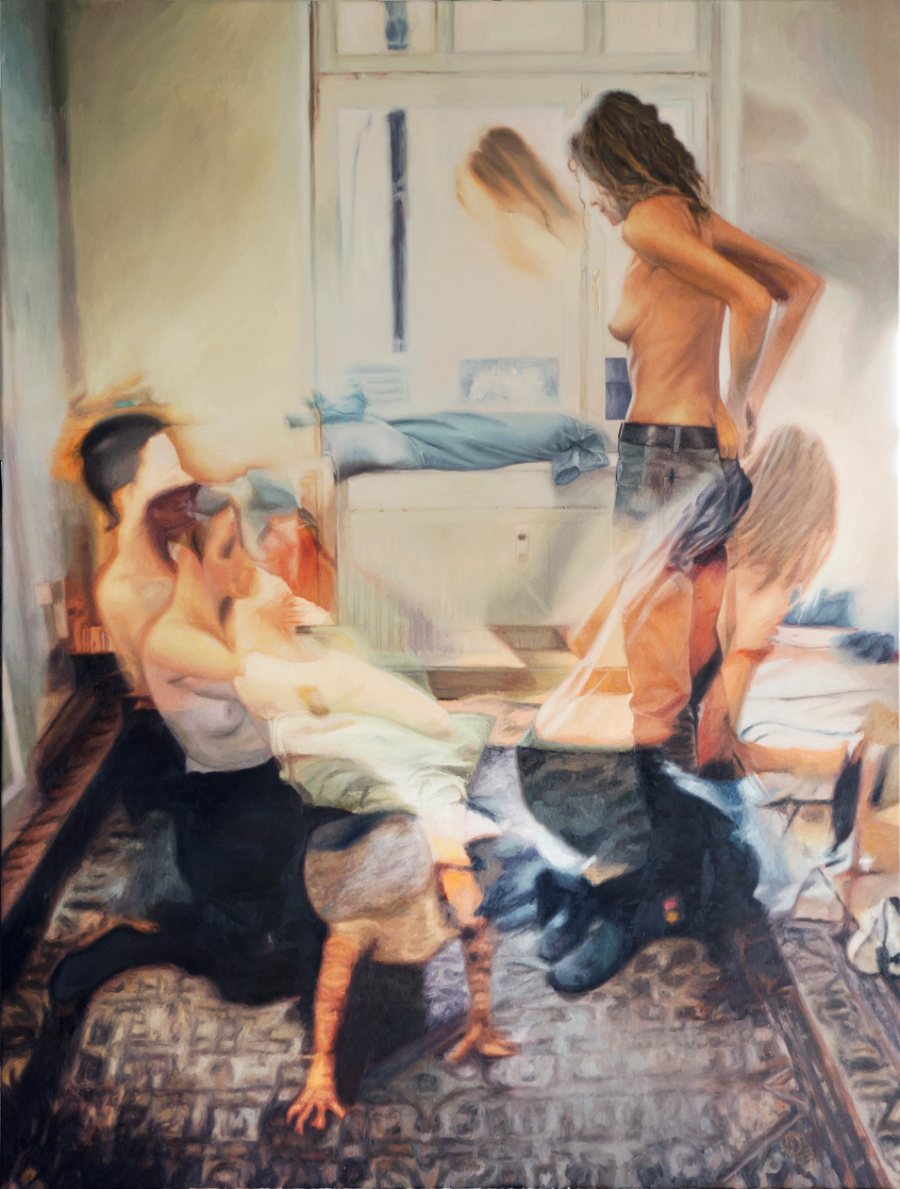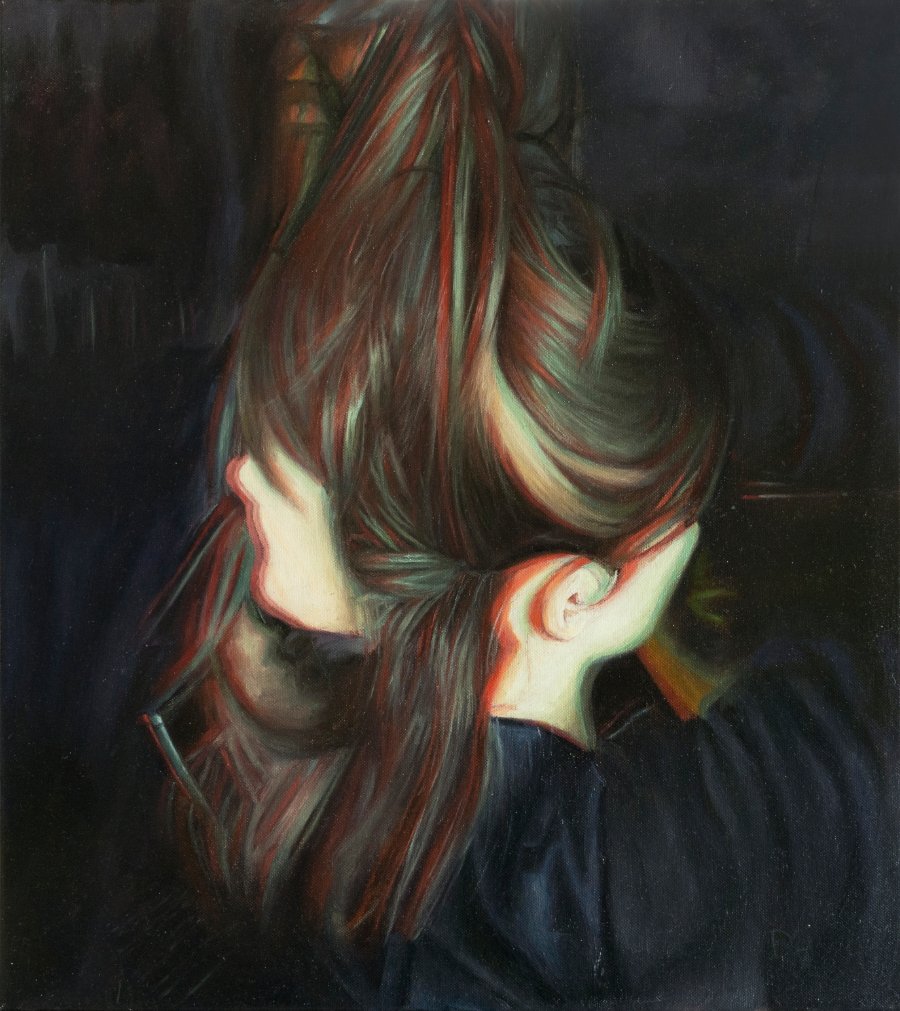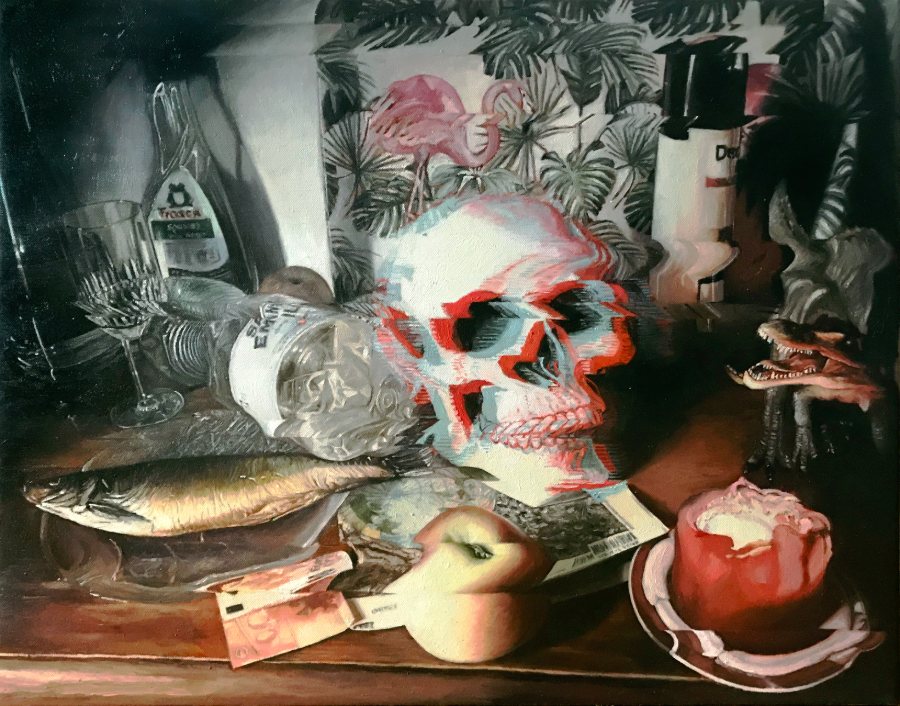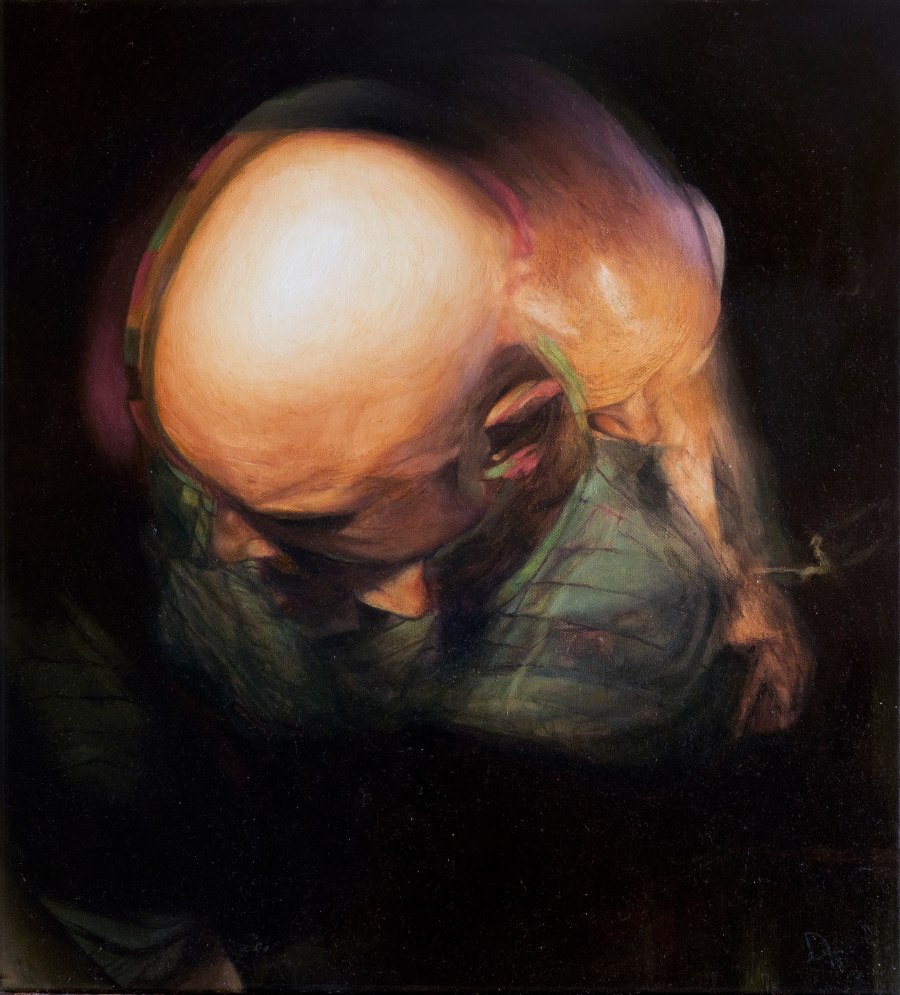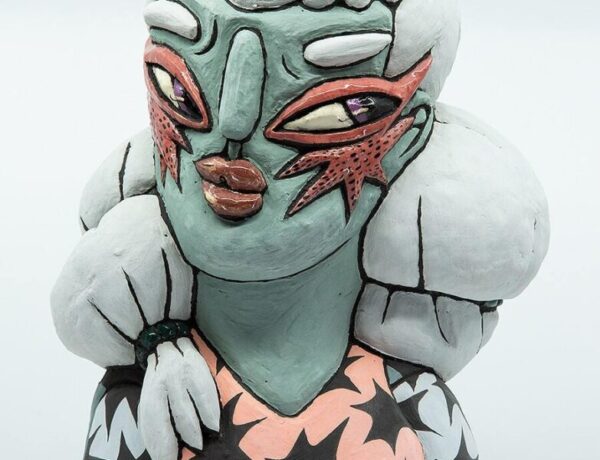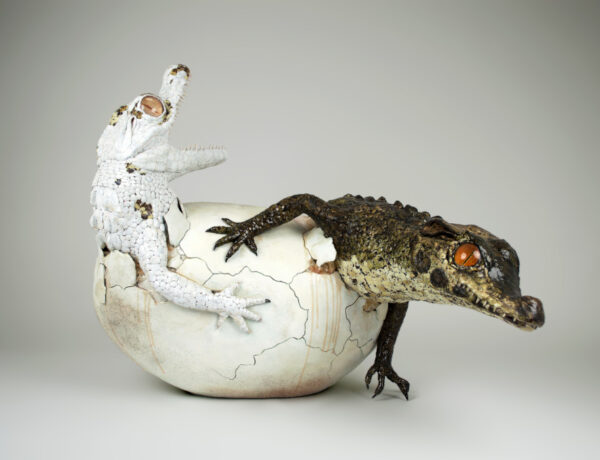Hidden beneath fastidiously applied brushstrokes and a mattified stratum of varnish, the true essence of a Diego Palacios painting quietly abides. It hopes. It dreams. It eagerly waits for the day when the beholder chooses to click the ‘modern day distraction’ mute button in favor of – gasp! – being fully present. “Shh-shhh-shhhhh!” it whispers breathlessly while observing us taking a contemplative pause. “The golden moment has finally arrived.”
While slowly studying the disquieting visages of Diego Palacios’ work splashed across this page – every last one invoked by the Chilean artist – basic questions begin to mount.
- What is happening to me?
- Why does this experience feel so… different?
- What is possessing me to view these paintings 100% mindfully?
Possessing, indeed.
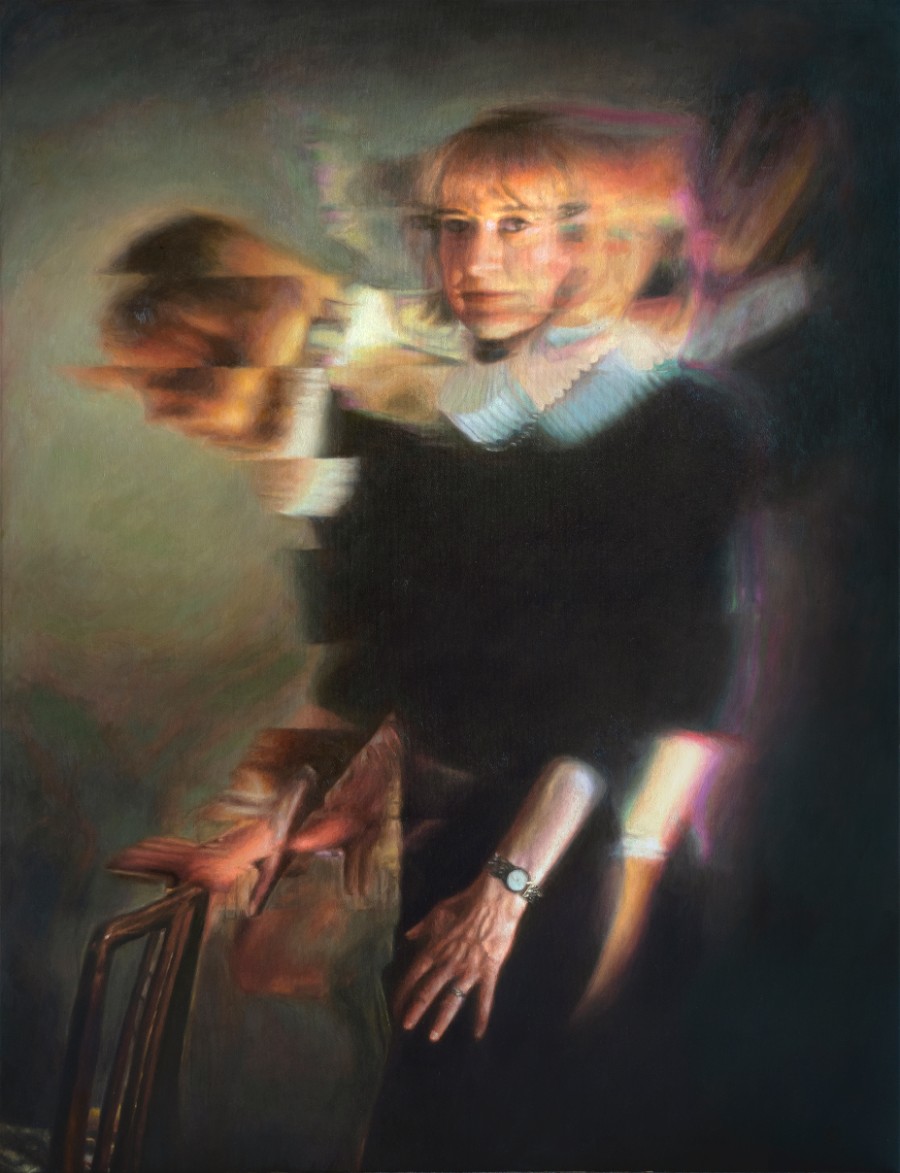
Viewing art can be a deliriously light-hearted pastime. At other times, gazing upon the creative output of others can be spirit-rallying, technically inspirational, or soul-deflating. What, however, makes an image positively entrancing? Is it a relatable, soul-stirring feeling? The protean quintessence of the human experience? Or, is it possible that oils lavished upon canvas can trigger an alchemically-aesthetic space-time continuum?
The witching hour of right-brained revelation is officially upon us. Diego Palacios has come to rescue us from our unrelenting, ever-perplexing train of thought by directly addressing matters of the philosophically artful super unknown.
I push technical boundaries so that my paintings are aesthetically and emotionally interesting. I like playing with the old-new figurative-contemporary boundary, as well. Stale or right out of the oven. I think it can trigger a melancholic response.

In the past six years that you’ve been a painter, you’ve dabbled in practically every style out there, haven’t you?
Haha, yes, that’s right. I tried various different styles in search of my own. When I first started painting, I was naive enough to think that a good painter is just someone who can technically paint well. I didn’t yet understand that technique is just one of the essential ingredients in a painting. I was always a great fan of 17th and 19th century artists, so being able to emulate their realism was so much fun. It also looked like a miracle – making paint do what one wants it to do. At the same time, I created modern and contemporary paintings, as well. After attending a Jacob Jordaens exhibition in Paris, though, my personal goal became crystal clear. I believed that the ability to paint in that manner was buried somewhere within me. I was intent on cultivating those skills.
Do you have a couple of sculptures hidden away in a dark closet that we should know about, too? Maybe a few illuminated manuscripts?
No sculptures, but I do have a couple of poems from years ago. As a wine salesman, I had to travel all the time. Writing poems became a coping mechanism for me during that weird period in my life. These days, however, I am 100% focused on painting.
Are you the kind of person who needs to try all of the toys in the room? Is consistent creative experimentation a part of your artistic code?
Yes, definitely! At the moment, I am exploring the different possibilities within the aesthetical boundaries of my two current series. When I’ve completed them, my experimentation might point toward a different path, organically. After working in a series for a while, the idea can get stale. That’s when I’m inspired to explore something new. It’s like trying the whole buffet, and then revisiting it to select my favourite foods.
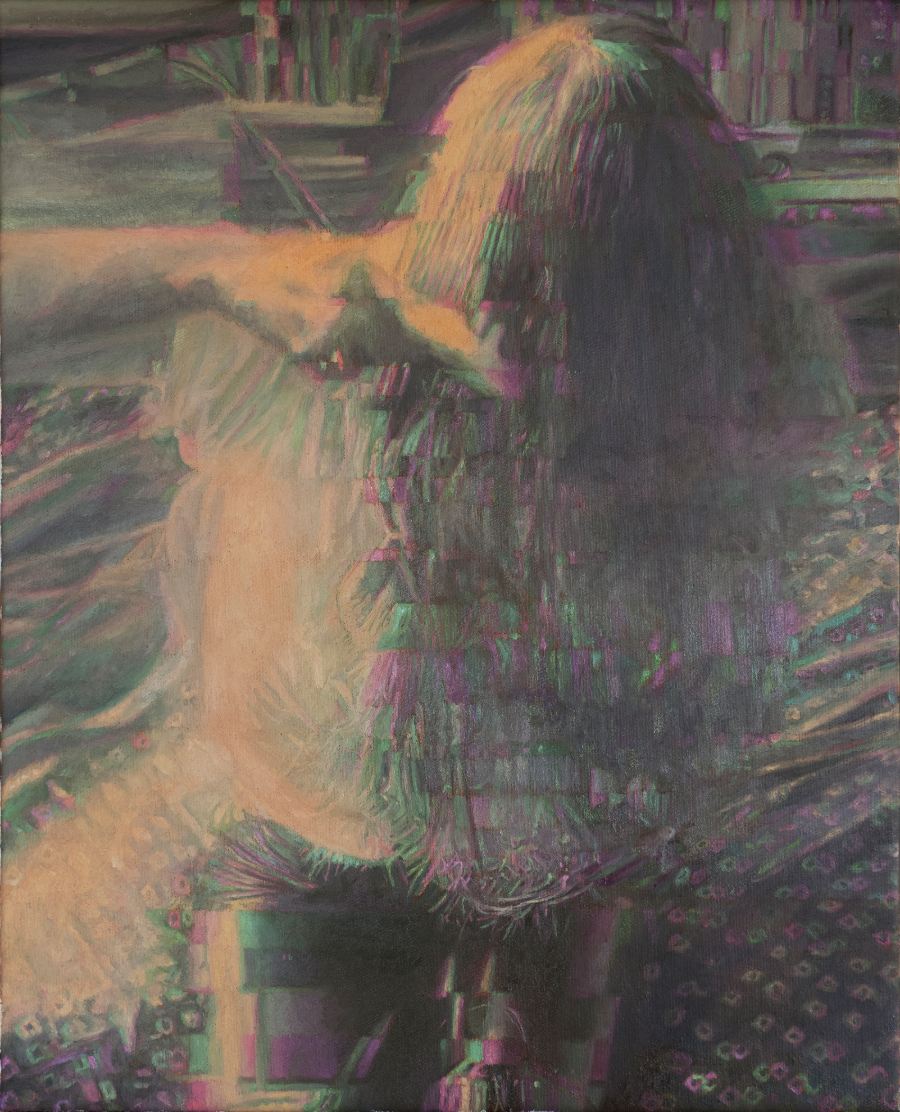
I always avoided defining myself. This avoidance was part of what defined me, quite honestly. But then the time comes when your history starts defining you. Fortunately, I feel that painting is exactly what I should be doing with my life.
Is pushing visual boundaries reflective of your personality or another factor?
I push technical boundaries so that my paintings are aesthetically and emotionally interesting. I like playing with the old-new figurative-contemporary boundary, as well. Stale or right out of the oven. I think it can trigger a melancholic response.
Quite like your painting style, your career path has morphed significantly over the years. You studied economics. Then you worked in the wine tasting biz. Are you a Libra or another indecisive astrological sign?
I am a Gemini and I am doomed. I studied economics and business mostly because of influences and some social pressure. My wine studies gave me the perfect justification to remain in France. Unfortunately, I had no big passion for it. At the time, I wasn’t really reflecting upon my decisions. I just kept the circus going by taking what I could when I could.
I always avoided defining myself. This avoidance was part of what defined me, quite honestly. But then the time comes when your history starts defining you. Fortunately, I feel that painting is exactly what I should be doing with my life.
Have you ever been pigeon-holed into a specific aesthetic?
Sure! Hyperrealist. Figurative. I hate both of those labels! An artist is probably on a good path when others say, “This looks like Diego Palacios painting.” I hope this comes one day. I’m working on it.
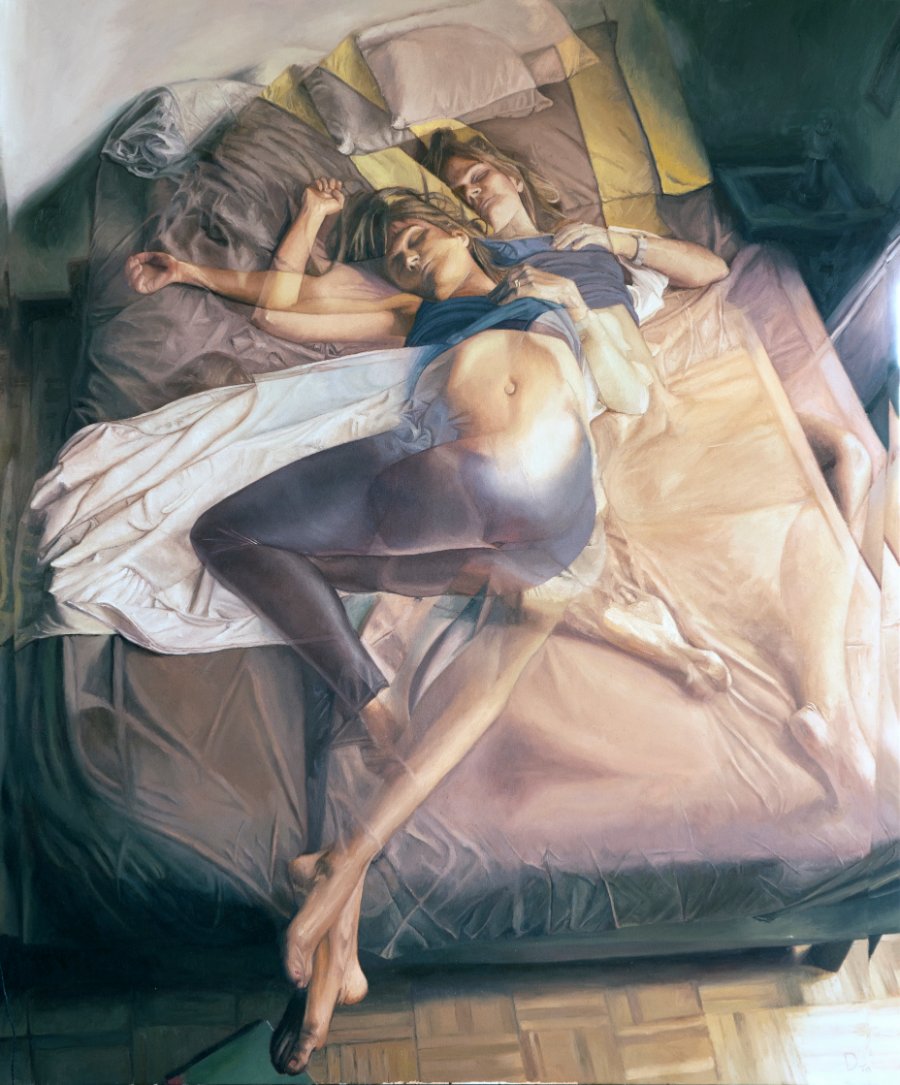
My real full-time job is pondering the meaning of life. I view my paintings as the by-products of these inner contemplations.
Many artists produce new work at a dizzying pace. Commercial pressure can be one big factor. The eager reception of fans can be another motivator. There are more than a few creatives who simply just fulfill their own prolific artistic goals. Where do you fit into the productivity spectrum?
Although my painting speed is rather fast, the process that I use requires many layers, which takes time. I imagine that different parts of the world have different painting religions. Of course I’m generalizing, but paintings tend to look looser in Leipzig than in New York or California. During my Leipzig art residency, I was encouraged to paint faster and to allow the paint and the accident to express itself. I play with this technique in some of my paintings, such as ‘In The Room’ or ‘Tillfällen’. Conversely, my Monochrome series of paintings are very controlled. I think one should try to give a painting the time that it needs, rather than forcing its birth. In my particular case, I fear that doing otherwise would harm my paintings.
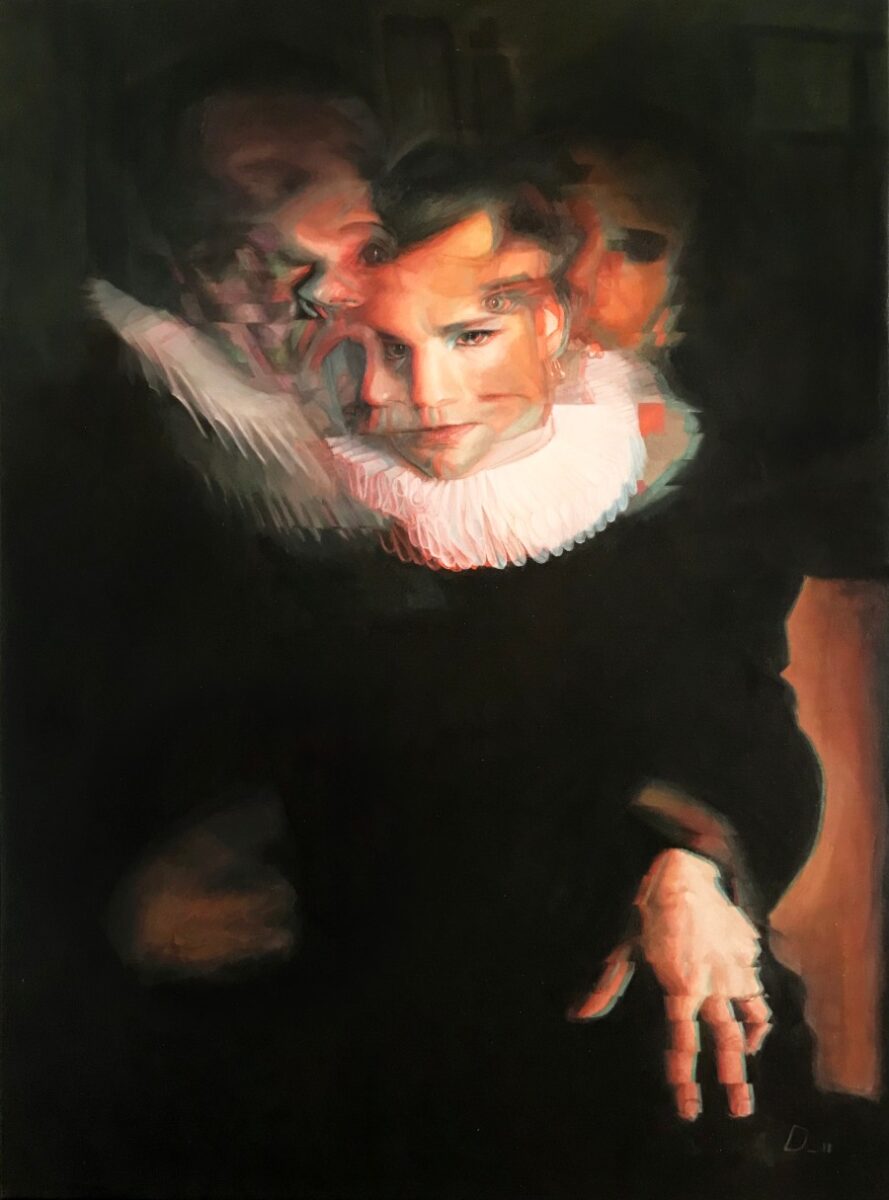
Those who explore your portfolio may initially show up for the pretty pictures. However, they soon realize that a mind-soul workout is part of the package deal. Has ruminating on the meaning of life always been a natural extension of your artistic practice?
My real full-time job is pondering the meaning of life. I view my paintings as the by-products of these inner contemplations. Some paintings are destined to be beautiful and others not exactly. They all have their place, like people, and somehow they are all okay. I do care about the general aesthetic appeal of my paintings, though. Composition, sense, and spatial coherence all figure prominently in my work.
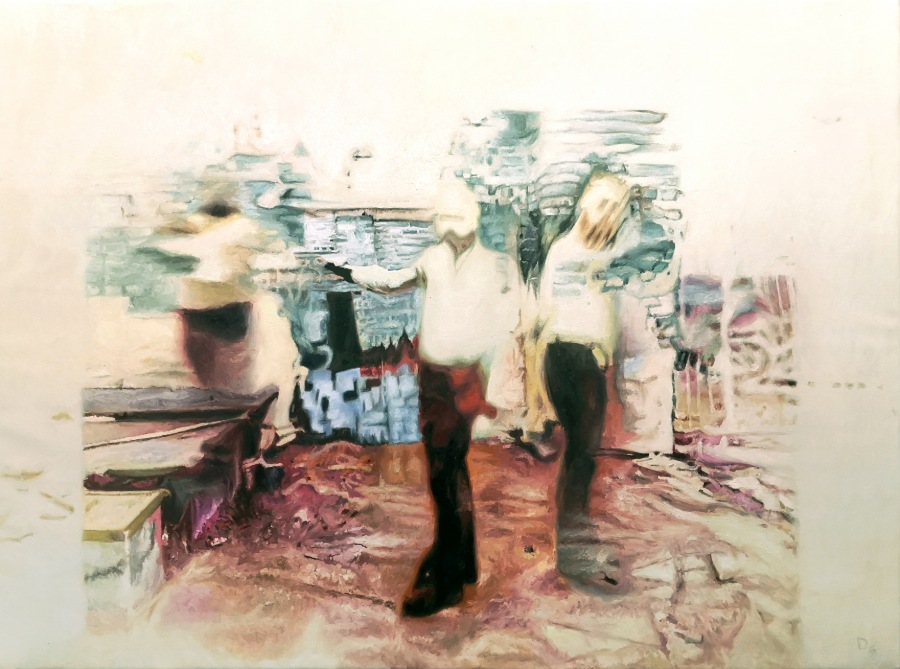
Is one of your main goals to imbue your brushstrokes with the emotional spectrum of the human spirit?
Sometimes, I wonder if art is matter carrying spirit, or if it is the language of the spirit of the world talking to itself, to us. Conveying the emotional essence of humanity through my brushstrokes would make me humbled and happy. For now, my mission is to achieve a greater understanding of art so that I can create something unique and emotional.
Being a skilled painter requires great dedication. Consistently weaving a multi-faceted emotional narrative into your paintings can consume even more effort. At times, does your ‘image plus inner emotions’ artistic standard ever feel like the bane of your creative existence?
Not at all! Bringing multi-faceted painting ideas to fruition is one of the most gratifying parts of my work. It charges me with energy, enthusiasm and it is a reflection of who I am. I like the beholder being intellectually stimulated and just wondering while looking at my work. Until recently, I was unconsciously accomplishing that. I saw something similar emerging in Adam Lupton’s work years ago and really loved it. I used that as a springboard, which I have continued to push forward in my personal artistic practice. It has now transformed into something else.
Some believe that a growing fetus has a parasitic relationship to its mother. From conception to completion, do your paintings require so much of your soul that they end up temporarily draining you?
I used to say, “I have just given birth to a painting”, although I view the process as more symbiotic. When I am fishing for ideas during the planning phase or I am actually painting, I definitely feel energized. Although, by the end of a painting, I often feel the way I would imagine a pregnant woman must feel during her final trimester. My painting is heavier and I long for the day when it finally sees the light.
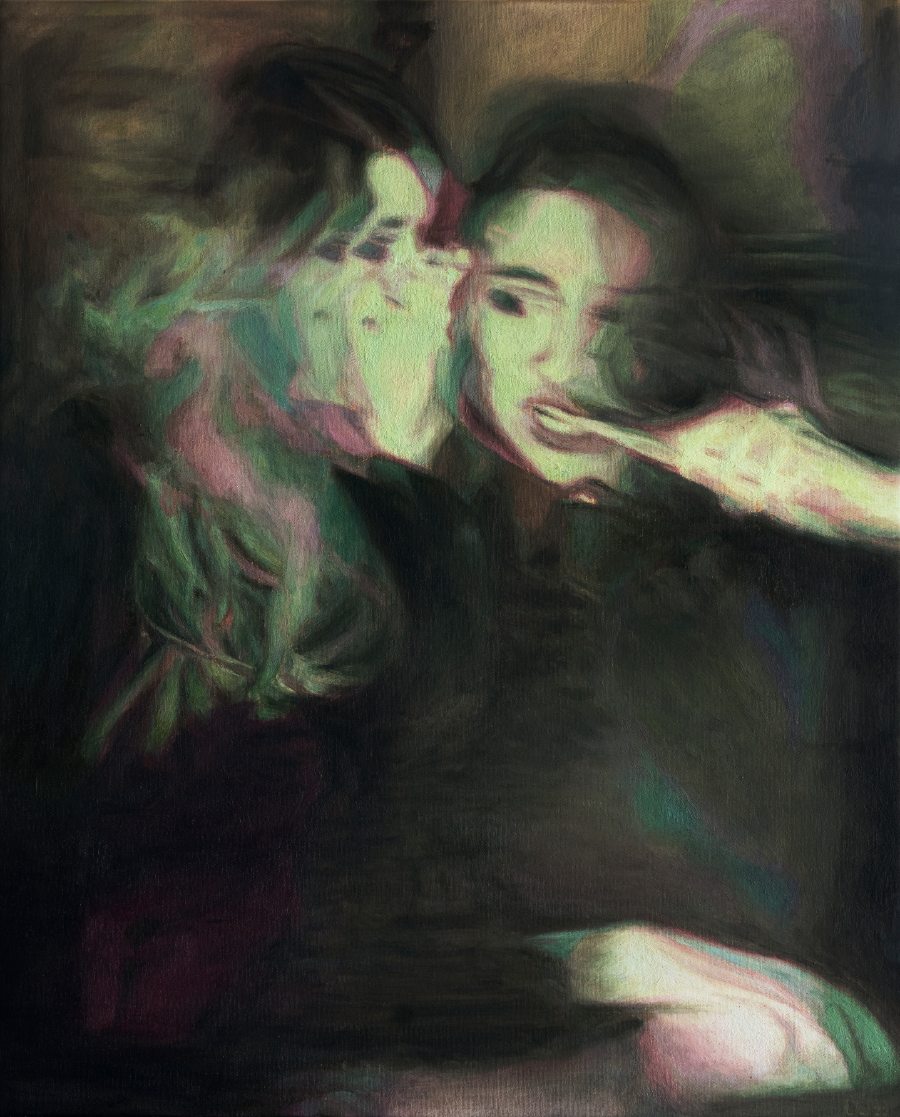
Your paintings – especially those in your latest series – reflect so many aspects of the human condition. It’s almost as though the faces gazing back at us possess a holographic range of emotions. How did you pull off that feat of magic?
Digitally contorting an image until it resembles an internal feeling is an important part of the process. Little by little, the concept of distorted intimacy – among other things – just started taking shape. I created idea lists, found good thematics, the necessary aesthetical ingredients, and worked on technical parameters.
The first time I created one of my Monochromed paintings, it was purely accidental. I was in the midst of my Leipzig art residency, and I thought about creating a ‘modern Rembrandt’. I realized that would be unlikely, of course, but I wondered if some part of Rembrandt’s soul might manifest during my process. Anyway, I decided to pose as one of his muses. With the assistance of various fellow artist-residents, we pulled together a fun photoshoot. While I was wearing theatrical makeup and a Chinese-made, Amazon-bought collar, we captured a wide range of images. One in particular literally enthralled me. It seemed to have enough merit to be featured in its own separate painting, which ended up becoming ‘Monochromefaced’.
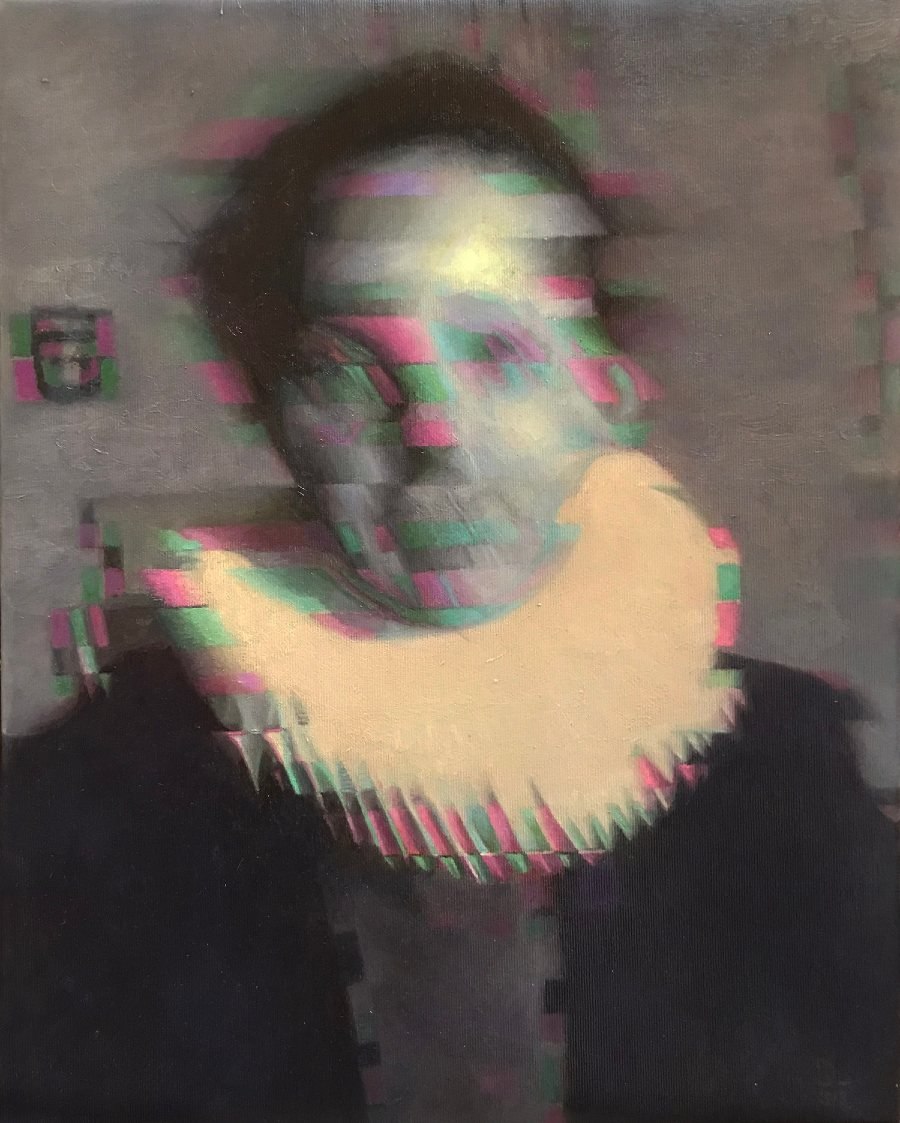
My paintings could be described as Rembrandt’s holographic warning message electronically transmitted from hell.
Your Monochromed series makes me think of static video footage that terrorists might share with major news media outlets. It also brings to mind the color-blocked broadcast system notification that was once displayed on American television during times of national emergency. That’s quite a vibe. Creatively speaking, do you think that art that invokes feelings like these is good, bad, or yikes?
Terrorists and emergency messages possess a quality – similar to that of my paintings – which makes your attention turn towards them. Despite their foreign strangeness and the amateurish nature of the footage, they still manage to reach us. People are reduced to anonymous entities, like the characters in my work. They all have a catastrophic quality to them, although my subjects are far more melancholy.
I think that effective art must transmit something, but the type of reaction that a painting triggers is personal. That doesn’t make it good or bad, unless perhaps the triggers are too obvious or exaggerated. I am just hoping that people can connect with me for just one second when they look at my work.
Many of the terms that are used to classify paintings don’t quite seem to apply to your Monochromed series. Does glitchy paneled portraiture accurately describe what you’ve been doing in this array of paintings?
My paintings could be described as Rembrandt’s holographic warning message electronically transmitted from hell. I do like your comment about how no current art classification seems exactly applicable to my paintings.
Is the unsettling undercurrent of Monochromed part of your master plan?
It is the beginning of my master plan. When we’re all Monochromed, it will already be too late.
Does it please you to learn that this collection of paintings triggers a “Whoa…what’s going on here?” feeling in the beholder?
Yeah, definitely. The worst would be indifference. I am aware that my paintings stir that kind of feeling in certain people. When an emotional reaction does happen, it is reassuring. It makes me glad and motivated.
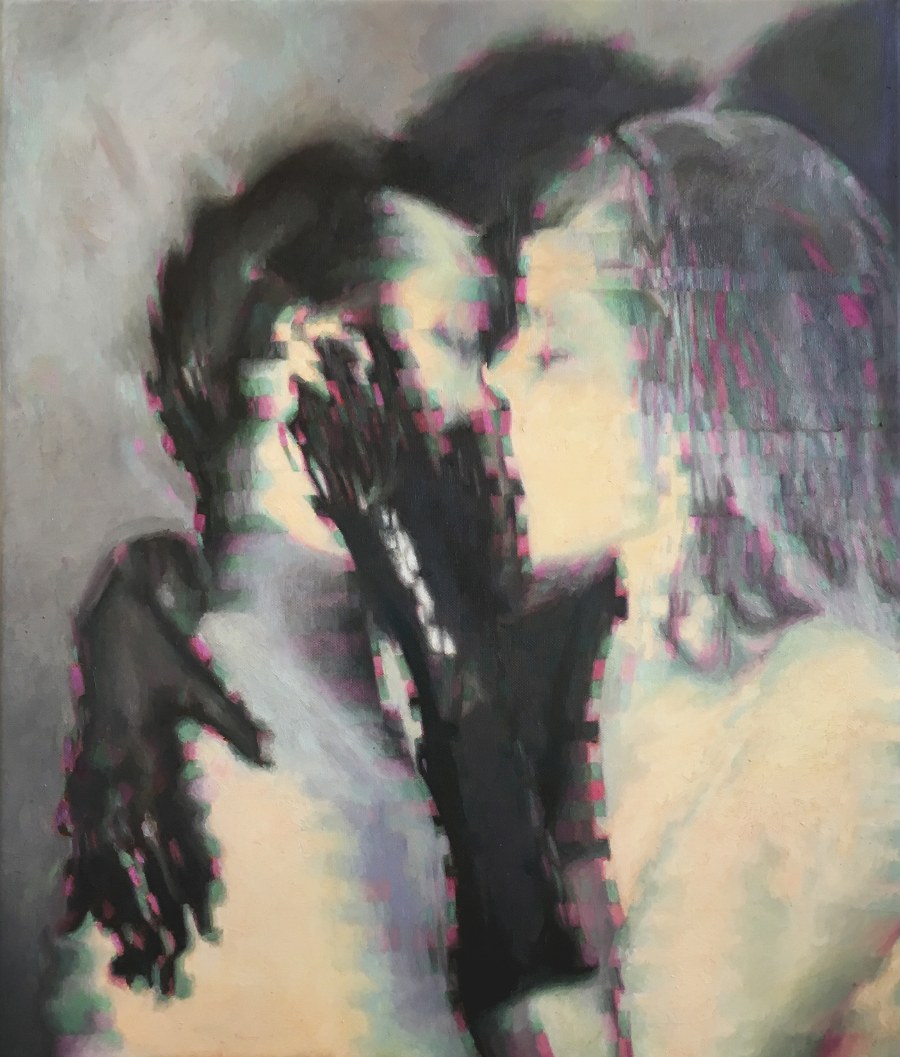
Tones of black, grey, and cream figure prominently in your edgy portraits. Accenting each painting with pink and green, however, unifies and electrifies them. How did this color hook happen?
Paintings have a soul but also a body, and they should work like ours do. My images require this ingredient so they can function aesthetically and possess some kind of graphic coherence. That particular color choice happened because I was trying to convey the digital aspect of this series. In the future, I might try full gray scale, but for the time being, tones like these enable me to project the VHS and digital world of the past directly into the present.
Your canvas complexions possess a silvery iridescence. Is this an artistic device meant to cast a pall upon your subject’s faces? Are you trying to summon the idea of death?
My fellow realistic painters and I are all a bit obsessive. We spend hours in front of our canvases, working on all the details. In the end, I think this control has something to do with avoiding death, or perhaps postponing it. Transcending it if we want to be reeeally optimistic. If my paintings somehow convey the idea of death, it’s accidental or perhaps just a subconscious result. I do recognise the eventual perdition of my characters, though. They might as well slowly and peacefully fade away.
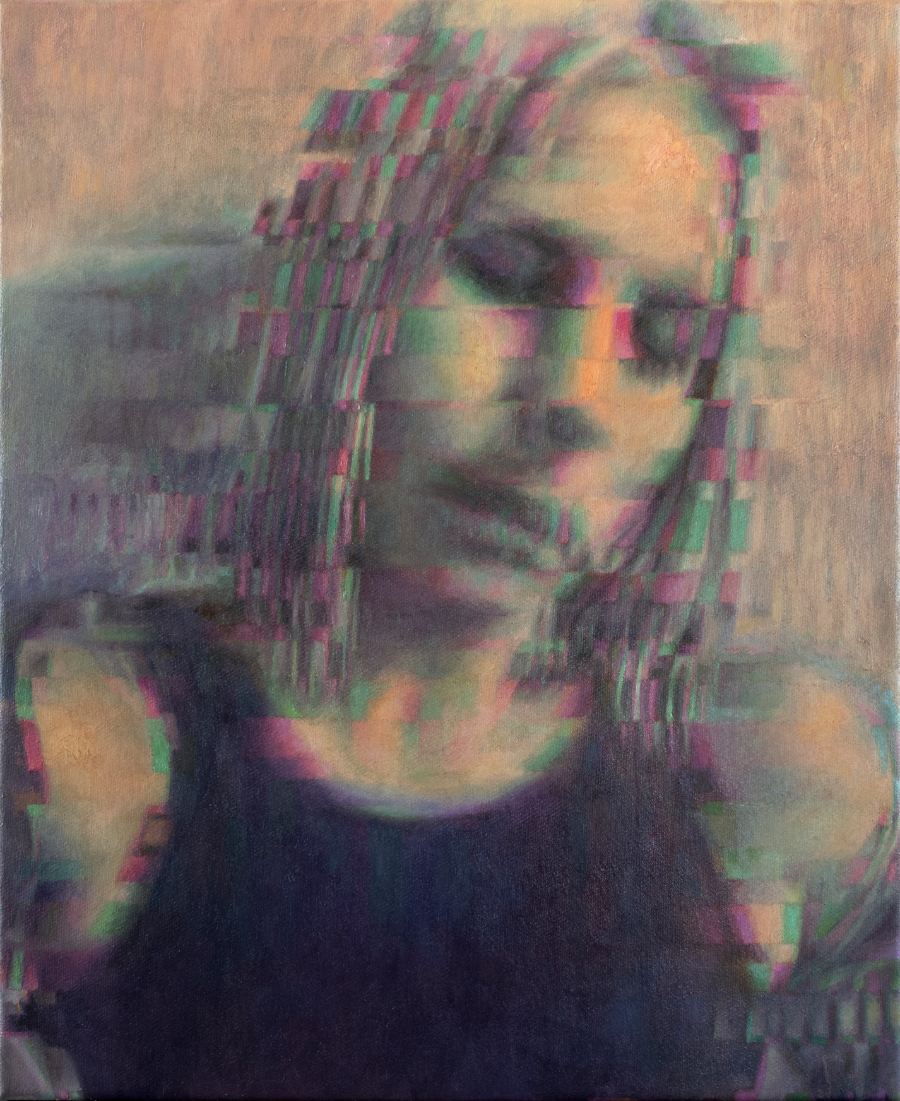
Some of your Monochromed visages appear to be entrenched within a metaphysical realm. Are the spirits of your canvas souls trapped in the in-between?
Perhaps they are on the other side of life and are just popping in to say “Hi!” before it’s over. And yet, they are still alive. Perhaps we just noticed them. It seems like some of them want us to see them, right?
Many of your Monochromed figures are strangely alluring. However, if the beholder were to get too close to your painted souls, it seems as though they’d yank us right through a purgatory porthole that they’ve clawed right into the canvas. Yes? No? Possibly?
You are very right about the purgatory porthole! The people in my paintings are trying to convey a pertinent message from another time or space, but the transmission has been distorted. If the beholder takes the first step towards them, they could very well be gentle and kind and have a positive message. Unfortunately, time has run out. Maybe the fact that these souls are fading is their real beauty. I prefer leaving my paintings open to interpretation since that’s what really imbues them with power. That reminds me of what the art historian Lea Asbrock champions – the idea of bringing art history back to the present. In regard to my canvas characters, I am just passing their message through. If the narrative in my paintings was obvious, perhaps they wouldn’t be as compelling.
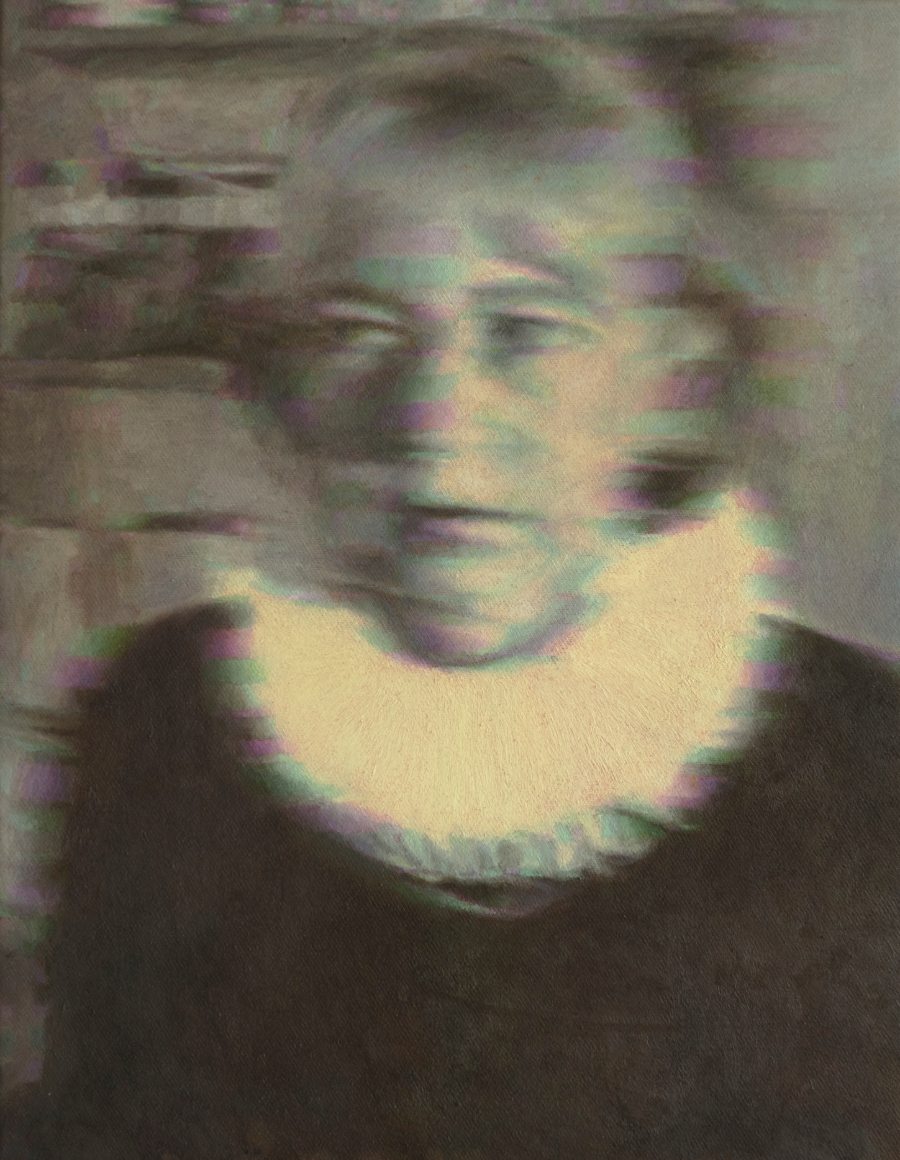
A few of your painted souls appear to be waiting for the perfect opportunity to initiate a mind-meld with the beholder.
In a way, that is my intention. Their big superpower is invoking intimacy and closeness among other human beings. The beholder experiences a stirring connection when they empathize with a canvas character who is passing through a purgatory porthole. Creating the same paintings – but with banal situations – would lead to a very different result. To a certain extent, my canvas characters are a reflection of all of us. We look at them in search of the qualities that resonate the most with us.
At other times, it appears as though some of them are doing things that, perhaps, are against their will?
Perhaps we’ve witnessed an intimate situation that we were not meant to see. It actually depends on each particular painting. The first time I flirted with the idea of seeing something that we’re not supposed to see was in a painting that I called ‘Entdeckung’, which means discovery. My 2018 solo exhibition was called ‘Schönes, Unbehagliches Schuldgefühl’, which means beautiful uncomfortable feeling of guilt. Back then, that was the childhood feeling that I was trying to convey. Some of it is still present in my Monochrome paintings.
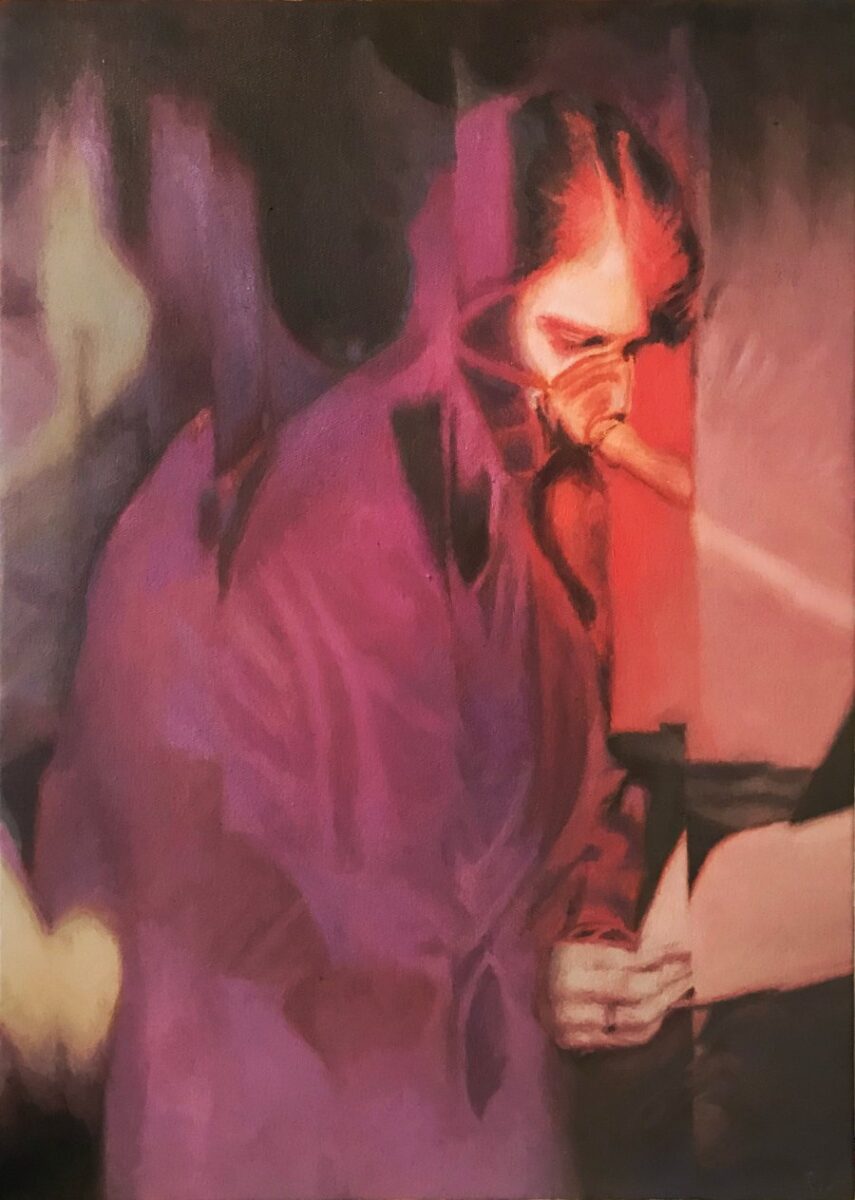
How do you think you’ll respond if your child, Anton, declares that he simply must live the life of an artist?
I’ll wish him good luck and tell him that he’ll probably eat loads of canned beans at the beginning of his career.
Imagine that one of the ghostly visages you painted was able to pull you through the canvas and into their realm. What would the other side look like?
Their realm might be far more familiar than we imagine – perhaps the transmission process itself has just deformed it. On the other hand, their world could look like death, or it could be a reflection of our deep and uncomfortable subconscious. In any event, I imagine that we might feel as though we are interrupting something or stepping into personal experiences. I can’t help but wonder what it would be like for them to step into our world. Would it be human enough?
What final message would you want to share with the world and your fan base if you were, in fact, stuck behind one of your own canvases?
First, thank you for looking. Second, please get me out of here.
